Stroke Diagnostics Market Size and Trends
The stroke diagnostics market is estimated to be valued at USD 3.34 Bn in 2025 and is expected to reach USD 5.83 Bn by 2032, growing at a compound annual growth rate (CAGR) of 8.3% from 2025 to 2032.
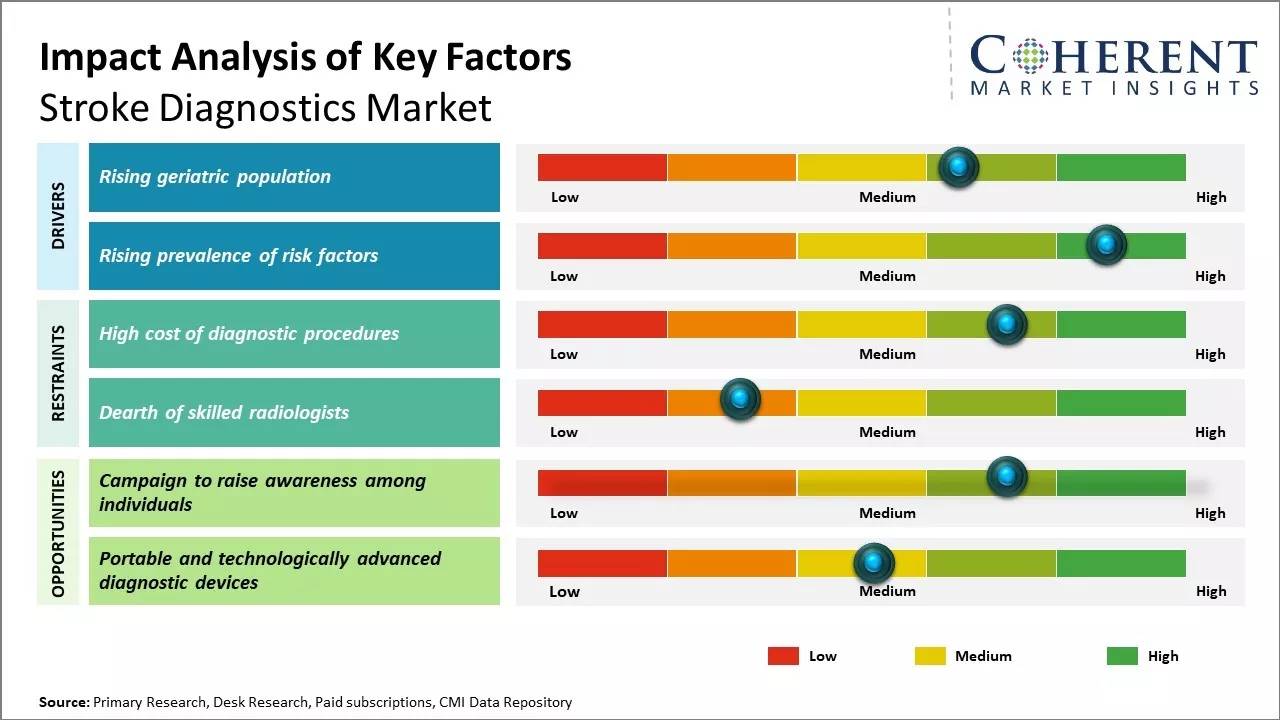
Discover market dynamics shaping the industry: Download Free Sample
Increased investments from both public and private players to develop advanced diagnostic technologies are supplementing the market growth. The stroke diagnostics market is expected to witness a positive trend over the forecast period. This is attributed to factors such as the rising geriatric population susceptible to stroke, growing prevalence of cardiovascular diseases and diabetes mellitus, favorable reimbursement policies, and increasing adoption of imaging modalities for stroke diagnosis. However, the high cost of advanced devices and lack of skilled professionals in developing economies may hinder the market growth.
Rising geriatric population
The global geriatric population, aged 65 years and above, has been on a steady rise over the past few decades. Advances in medical technologies as well as improvement in standard of living in developed as well as developing countries have contributed significantly to improved life expectancy. However, aging also predisposes individuals to increased risks of various chronic diseases and health conditions. Stroke is one of the most common health conditions associated with advanced age, as risk of stroke doubles with every decade of life after 55 years of age. With continued improvement in life expectancy worldwide, the oldest old population segment, aged 80 years and above, considered as the high-risk group for stroke, is expected to grow rapidly in the coming years. This consistent growth of the geriatric demographic particularly in developed nations will drive greater demand for effective stroke diagnostics and monitoring solutions for timely diagnosis and treatment.
Market Concentration and Competitive Landscape
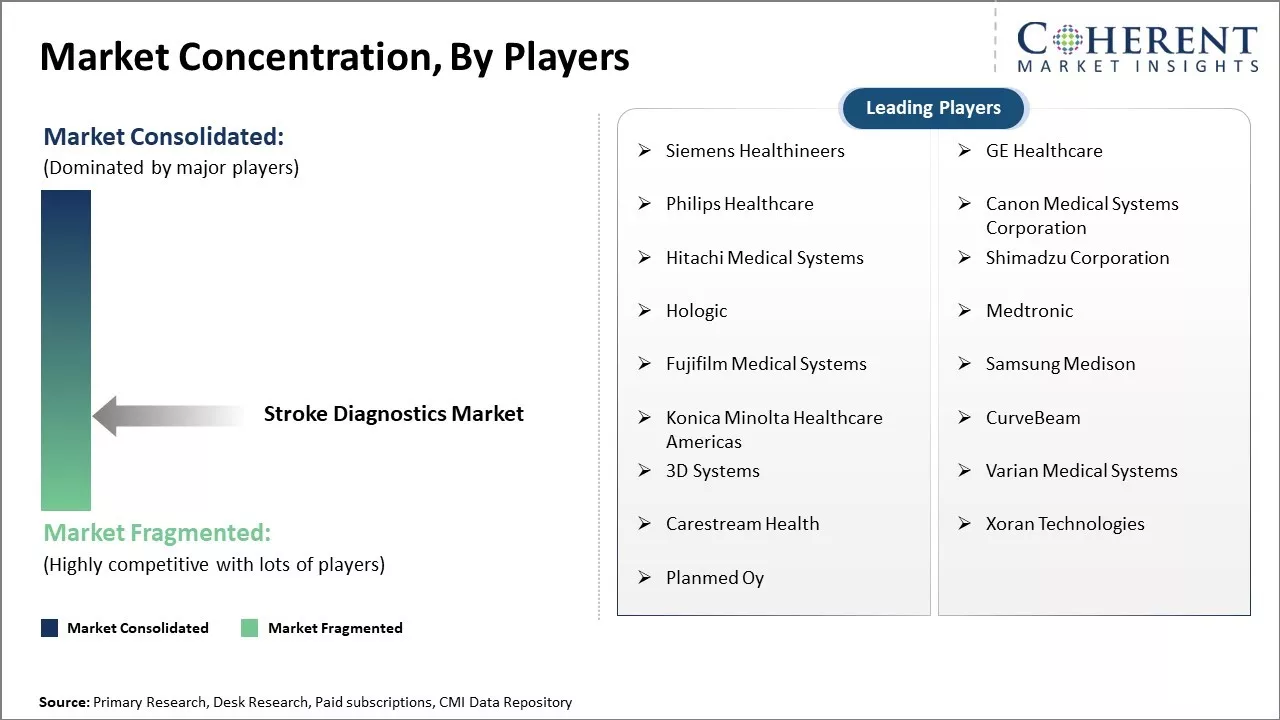
Get actionable strategies to beat competition: Download Free Sample
Rising prevalence of risk factorsRising prevalence of risk factors such as high blood pressure, obesity, diabetes, heart disease, and unhealthy lifestyle habits are significantly propelling the growth of the global stroke diagnostics market. These risk factors are becoming increasingly common around the world due to changing dietary patterns, lack of physical activity, increased stress levels and growing geriatric population. Moreover, the COVID-19 pandemic has further amplified these risk trends. Studies show that people with stroke history or risk factors like diabetes have higher chances of developing severe COVID-19. They also tend to have poorer outcomes. Prolonged stress of the pandemic along with limited mobility and access to healthcare has worsened disease management for many patients worldwide. This has boosted the demand for effective stroke screening and diagnosis solutions.
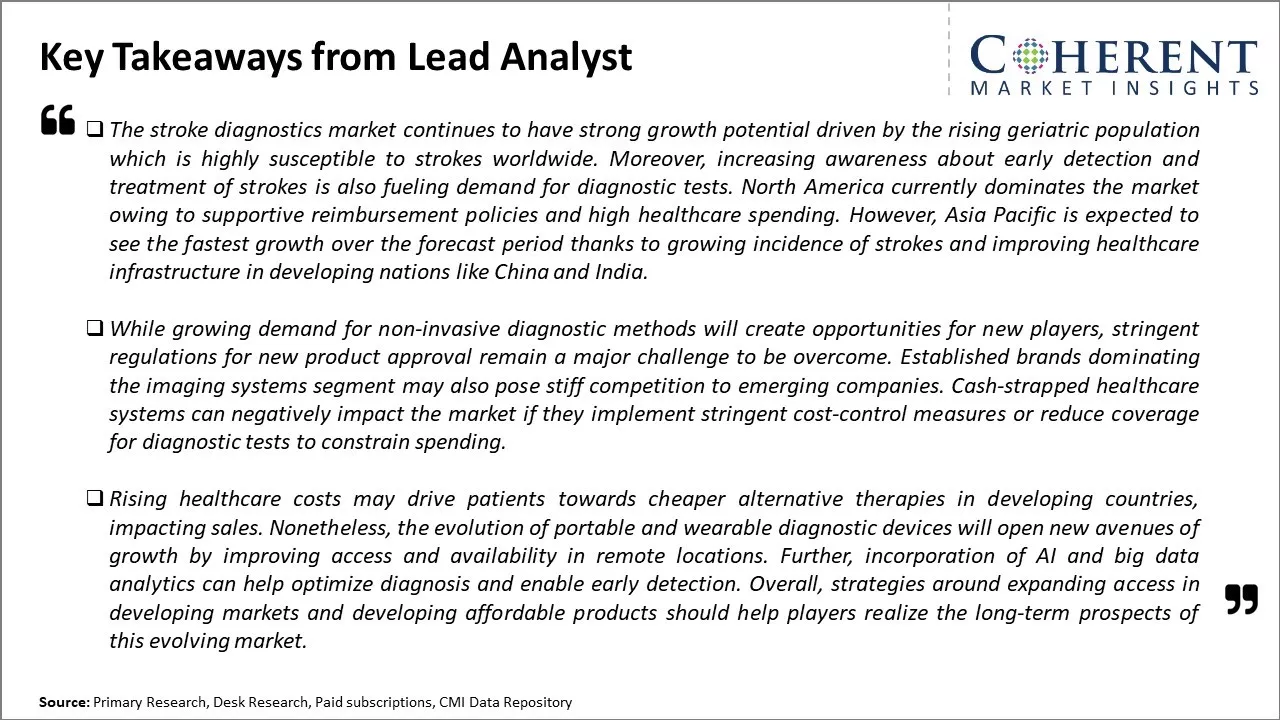
To learn more about this report, Download Free Sample
Market Challenges: High cost of diagnostic procedures
The stroke diagnostics market faces several challenges. Correctly identifying the type of stroke early is difficult, as the symptoms of ischemic and hemorrhagic strokes can be similar. Additionally, many diagnostic tools are expensive and inaccessible in developing regions with a high stroke burden. Low awareness in at-risk populations delays treatment. Reimbursement policies also vary greatly between countries and healthcare systems. These factors potentially reduce the number of strokes that can be effectively treated through timely diagnosis.
Market Opportunities: Campaign to raise awareness among individuals
As the global population ages and lifestyle-related risk factors rise, stroke incidents are projected to increase dramatically. Efforts to raise awareness and expand low-cost diagnostics to underserved areas could drive new revenue streams. Rapid diagnostics near the point of care have the potential to improve outcomes and streamline emergency response. Furthermore, technological advancements may deliver accurate, portable solutions, thereby creating lucrative growth opportunities over the forecasted period.
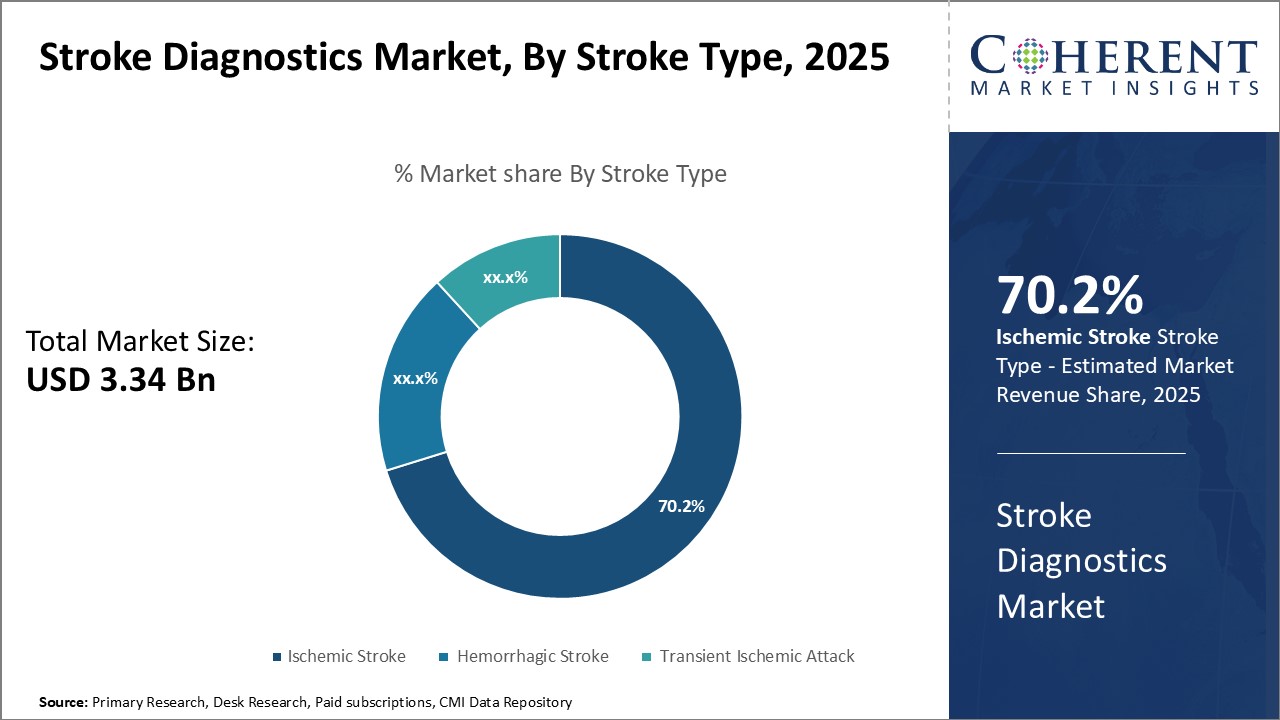
Discover high revenue pocket segments and roadmap to it: Download Free Sample
Insights, By Stroke Type: Rising Prevalence of Risk Factors Propel the Ischemic Stroke Segment Growth
The stroke type segment includes ischemic stroke, hemorrhagic stroke, and transient ischemic attack. Ischemic stroke segment is anticipated to hold 70.2% of the market share in 2025. Hypertension, diabetes, obesity, high cholesterol, and lifestyle habits like smoking and lack of exercise are some of the risk factors associated with ischemic stroke. These risk factors are increasingly common among modern populations due to changes in diet and physical activity levels. As populations in developed nations continue aging, the incidence of hypertension and other vascular risk factors climbs steadily. This translates to higher medical needs for diagnosing ischemic strokes, which arise from blockages or clots within blood vessels supplying the brain. Another driver is the availability of specialized diagnostic tools that can accurately identify occlusions and blockages causing ischemic strokes. Technologies like Computed Tomography (CT) angiography, Magnetic Resonance angiography, Doppler ultrasound, and X-rays are widely adopted for rapid diagnosis. Emergency departments in major hospitals now have dedicated stroke teams and protocols to swiftly diagnose ischemic strokes using such modalities.
Insights, By Imaging Test Type: Advances in Imaging Augment Computerized Tomography Usage
The imaging test type segment includes computerized tomography (CT) scan, magnetic resonance imaging (MRI), carotid ultrasound, positron emission tomography (PET), and others. computerized tomography (CT) scan is expected to occupy the highest share of the stroke diagnostics market and is projected to hold 43.3% of the market share in 2025. CT scans provide physicians a quick, non-invasive means to clearly visualize brain structures and identify signs of hemorrhage from damaged vessels. It plays a central role in the management of acute hemorrhagic and ischemic strokes in emergency settings. CT is also able to detect older bleeds and assess the extent of brain injury from pending hematomas. Newer multi-detector helical CT scanners have vastly improved the speed, resolution and volume coverage abilities of these systems. CT is now capable of advanced applications like perfusion imaging to gauge blood flow perturbations caused by thrombi or emboli. Such functional data complements anatomical details to better characterize stroke subtypes and extent. CT angiography delivers high-resolution visualization of brain and neck vasculature, aiding diagnosis of vessel dissections or aneurysms behind hemorrhagic strokes. Portable mobile CT units have broadened its availability to rural areas and ambulances as well.
Insights, By End User: Diagnostic Laboratories Dominate Due to Centralized Stroke Evaluation Models
The end user segment includes diagnostic laboratories, hospitals, specialty clinics, academic & research institutes, and others. The diagnostic laboratories segment is expected to hold the leading market share, i.e., 46.4% in 2025 as centralized lab-based models gain more acceptance for stroke evaluation. In such models, either the patient is transported from the hospital emergency room to the laboratory for comprehensive tests, or a mobile stroke unit equipped laboratory visits the patient directly at the onset of symptoms. Top diagnostic labs are extensively equipped with advanced imaging technologies like MRI, CT, angiography, ultrasound, as well as clinical pathology services under one roof. They also employ specialized stroke neurologists and neurovascular surgeons for consolidated diagnosis and care. Centralized labs offer numerous benefits over hospital-based testing including faster turnaround of complex investigations, dedicated stroke diagnosticians, standardized treatment protocols, and integrated multimodal imaging capabilities essential for obtaining a complete vasculature profile. They can leverage high volumes for more efficient resource utilization and better outcomes. Major lab chains have also established telestroke networks to enable rapid remote evaluation via telemedicine when primary stroke centers lack on-site expertise.
Regional Insights
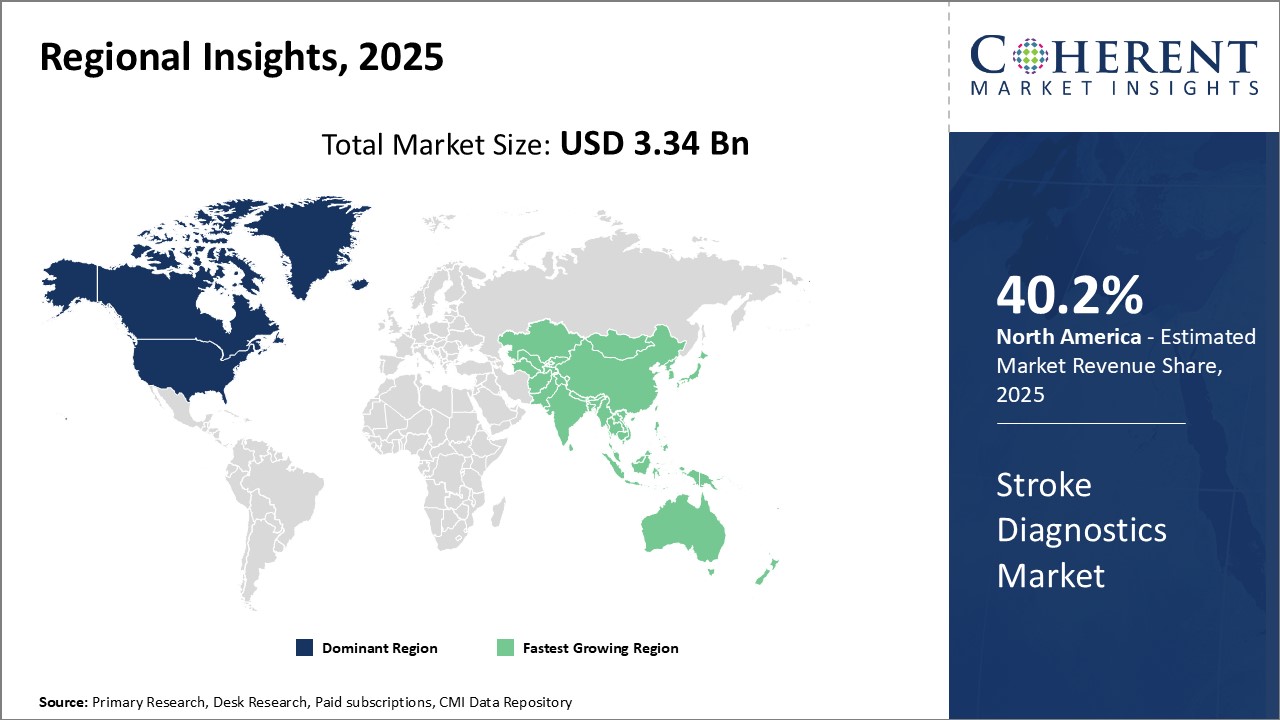
Need a Different Region or Segment? Download Free Sample
North America has established itself as the dominant region in the global stroke diagnostics market and is expected to hold 40.2% of the market share in 2025. This can be attributed to several factors within the region. Firstly, the U.S. is home to many major stroke diagnostics. These companies have extensive manufacturing facilities and R&D centers located within the country which allow them to cater effectively to the domestic market. In addition, healthcare expenditure is higher in the U.S. compared to other regions, increasing affordability and access to advanced diagnostic technologies. Strong reimbursement policies for stroke diagnosis and treatment also incentivizes adoption of new products in the region.
Meanwhile, Asia Pacific has emerged as the fastest growing regional market. Countries like China, India and Japan offer immense opportunities due to their massive population sizes which are increasingly aging. This translates to a growing patient base susceptible to age-related conditions like strokes. These Asia Pacific nations are also dedicated to modernizing their healthcare infrastructure and raising diagnostic capabilities. For instance, various government initiatives in India are promoting localized manufacturing of medical devices through incentives. This has encouraged global players to either set up manufacturing units themselves or engage in collaborations with local partners. The improving diagnostic infrastructure and supportive regulatory environment makes Asia Pacific an attractive investment destination for companies.
Market Report Scope
Stroke Diagnostics Market Report Coverage
| Report Coverage | Details | ||
|---|---|---|---|
| Base Year: | 2024 | Market Size in 2025: | USD 3.34 Bn |
| Historical Data for: | 2020 To 2024 | Forecast Period: | 2025 To 2032 |
| Forecast Period 2025 to 2032 CAGR: | 8.3% | 2032 Value Projection: | USD 5.83 Bn |
| Geographies covered: |
|
||
| Segments covered: |
|
||
| Companies covered: |
Siemens Healthineers, GE Healthcare, Philips Healthcare, Canon Medical Systems Corporation, Hitachi Medical Systems, Shimadzu Corporation, Hologic, Medtronic, Fujifilm Medical Systems, Samsung Medison, Konica Minolta Healthcare Americas, CurveBeam, 3D Systems, Varian Medical Systems, Carestream Health, Xoran Technologies, and Planmed Oy |
||
| Growth Drivers: |
|
||
| Restraints & Challenges: |
|
||
Uncover macros and micros vetted on 75+ parameters: Get instant access to report
Stroke Diagnostics Industry News
- In December 2023, Siemens Healthineers, a medical device company, and S.I.S Hospital, a major private healthcare hospital in Vietnam, unveiled the cutting-edge NAEOTOM Alpha, a huge step forward in diagnostic imaging. In a parallel development, S.I.S Hospital and Siemens Healthineers inked a master agreement for research partnership, with the goal of accelerating acute stroke protocols utilizing the most recent Deep Resolve method on MRI systems.
- In October 2023, Brainomix Ltd, an Artificial Intelligence (AI)-powered medtech solutions company, and Nanoflex Robotics AG, a remote robotic surgical company based in Switzerland, received a grant under the "UK - Switzerland Bilateral: Collaborative R&D" program. The companies will collaborate to develop an integrated remote diagnosis and treatment platform for stroke powered by artificial intelligence.
- In July 2023, Hyperfine, Inc., the company behind the first U.S. Food and Drug Administration -cleared point-of-care magnetic resonance imaging (MRI) equipment, Swoop, announced the start of an international, multi-site observational research called ACTION PMR (ACuTe Ischemic StrOke DetectioN with Portable MR). Hyperfine Inc. has established an advisory group of world-renowned stroke experts to help with its acute stroke care activities.
- In July 2022, Viz.ai, the premier AI-powered disease detection and intelligent care coordination platform, announced a partnership with Hyperfine, Inc. Viz.ai's core product, Viz LVO, which uses powerful deep learning to send time-sensitive information about stroke victims directly to a professional who can intervene and treat.
Definition: The stroke diagnostics market consists of medical devices, imaging systems, and other technologies used by healthcare professionals to diagnose patients who may be experiencing a stroke. This market provides tools like CT scanners, MRI machines, ultrasound devices, and biomarker tests that can quickly identify if a patient is having an ischemic stroke, hemorrhagic stroke, or transient ischemic attack. Early diagnosis is critical, as stroke treatments are time-sensitive.
Market Segmentation
- Stroke Type Insights (Revenue, USD BN, 2020 - 2032)
- Ischemic Stroke
- Hemorrhagic Stroke
- Transient Ischemic Attack
- Imaging Test Type Insights (Revenue, USD BN, 2020 - 2032)
- Computerized Tomography (CT) Scan
- Magnetic Resonance Imaging (MRI)
- Carotid Ultrasound
- Echocardiogram
- Positron Emission Tomography (PET)
- Others
- End User Insights (Revenue, USD BN, 2020 - 2032)
- Diagnostic Laboratories
- Hospitals
- Specialty Clinics
- Academic & Research Institutes
- Others
- Regional Insights (Revenue, USD BN, 2020 - 2032)
- North America
- U.S.
- Canada
- Latin America
- Brazil
- Argentina
- Mexico
- Rest of Latin America
- Europe
- Germany
- U.K.
- Spain
- France
- Italy
- Russia
- Rest of Europe
- Asia Pacific
- China
- India
- Japan
- Australia
- South Korea
- ASEAN
- Rest of Asia Pacific
- Middle East
- GCC Countries
- Israel
- Rest of Middle East
- Africa
- South Africa
- North Africa
- Central Africa
- North America
- Key Players Insights
- Siemens Healthineers
- GE Healthcare
- Philips Healthcare
- Canon Medical Systems Corporation
- Hitachi Medical Systems
- Shimadzu Corporation
- Hologic
- Medtronic
- Fujifilm Medical Systems
- Samsung Medison
- Konica Minolta Healthcare Americas
- CurveBeam
- 3D Systems
- Varian Medical Systems
- Carestream Health
- Xoran Technologies
- Planmed Oy
Share
Share
About Author
Manisha Vibhute is a consultant with over 5 years of experience in market research and consulting. With a strong understanding of market dynamics, Manisha assists clients in developing effective market access strategies. She helps medical device companies navigate pricing, reimbursement, and regulatory pathways to ensure successful product launches.
Missing comfort of reading report in your local language? Find your preferred language :
Transform your Strategy with Exclusive Trending Reports :
Frequently Asked Questions
EXISTING CLIENTELE
Joining thousands of companies around the world committed to making the Excellent Business Solutions.
View All Our Clients
